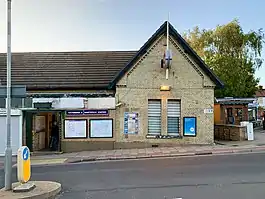Totteridge & Whetstone tube station
Totteridge & Whetstone (/ˈwɛtstoʊn/) is a London Underground station in Whetstone in the London Borough of Barnet, North London. The station is the penultimate one on the High Barnet branch of the Northern line, between High Barnet and Woodside Park stations, in Travelcard Zone 4.[7] It was first built in 1872.
| Totteridge & Whetstone | |
|---|---|
 Station entrance | |
 Totteridge & Whetstone Location of Totteridge & Whetstone in Greater London | |
| Location | Whetstone |
| Local authority | London Borough of Barnet |
| Managed by | London Underground |
| Number of platforms | 2 |
| Fare zone | 4 |
| London Underground annual entry and exit | |
| 2018 | |
| 2019 | |
| 2020 | |
| 2021 | |
| 2022 | |
| Key dates | |
| 1 April 1872 | Opened (GNR) |
| 14 April 1940 | Started (Northern line) |
| 1941 | Ended (LNER) |
| 1 October 1962 | Goods yard closed[6] |
| Other information | |
| External links | |
| WGS84 | 51.63056°N 0.17917°W |
It is on the north side of Totteridge Lane (A5109), to the east of the Dollis Brook, the traditional boundary between Totteridge and Whetstone, so narrowly in the latter.[8]
History
The Totteridge & Whetstone station was planned by the Edgware, Highgate and London Railway (EH&LR) and was originally opened as Whetstone and Totteridge on 1 April 1872 by the Great Northern Railway (which had taken over the EH&LR).[9] The station was on a branch of a line whose main part ran from Finsbury Park to Edgware via Highgate.
After the 1921 Railways Act created the Big Four railway companies the line was, from 1923, part of the London and North Eastern Railway (LNER). The section of the High Barnet branch north of East Finchley was incorporated into the London Underground network through the "Northern Heights" project which began in the late 1930s. Totteridge and Whetstone station was first served by Northern line trains on 14 April 1940[10] and, after a period where the station was serviced by both operators, LNER services ended in 1941.[9]
British Rail (the successor to the LNER) freight trains continued to serve the station's goods yard until 1 October 1962, when it was closed.[6]
Station facilities
The station retains much of its original Victorian architectural character today.[11] The station is not wheelchair accessible[12] owing to flights of stairs to the two platforms.
The station has in the 21st century undergone subtle changes to enable the policy of no ticket offices, chiefly:
- an automatic double-wide access, disabled and buggy-friendly barrier
- A help desk instead of the ticket office.
The station is not often staffed but is during peak hours. The station has a passenger hall, four gates, two toilets (a female toilet on the southbound platform and a male toilet on the northbound platform), a car park and waiting rooms.[13]
Services and connections
Train frequencies vary throughout the day, but generally operate every 3–6 minutes between 6:04 and midnight in both directions.[14][15]
London Bus routes 34, 125, 234, 251, 263, 326, 383, 605, 626, 628, 634 and 688 and night route N20 serve the station.[16][17][18]
Gallery
 Southbound platform looking north
Southbound platform looking north Southbound platform looking south
Southbound platform looking south Roundel on the northbound platform
Roundel on the northbound platform
References
- "Station Usage Data" (CSV). Usage Statistics for London Stations, 2018. Transport for London. 23 September 2020. Archived from the original on 14 January 2023. Retrieved 11 October 2023.
- "Station Usage Data" (XLSX). Usage Statistics for London Stations, 2019. Transport for London. 23 September 2020. Archived from the original on 9 November 2020. Retrieved 9 November 2020.
- "Station Usage Data" (XLSX). Usage Statistics for London Stations, 2020. Transport for London. 16 April 2021. Retrieved 1 January 2022.
- "Station Usage Data" (XLSX). Usage Statistics for London Stations, 2021. Transport for London. 12 July 2022. Retrieved 7 September 2022.
- "Station Usage Data" (XLSX). Usage Statistics for London Stations, 2022. Transport for London. 4 October 2023. Retrieved 10 October 2023.
- "Underground: The Journal of the London Underground Railway Society" (PDF) (12). December 1962: 7. Retrieved 28 November 2017.
{{cite journal}}: Cite journal requires|journal=(help) - Standard Tube Map (PDF) (Map). Not to scale. Transport for London. November 2022. Archived (PDF) from the original on 7 November 2022. Retrieved 12 November 2022.
- Google Maps – Totteridge and Whetstone Tube Station
- Clive's Underground Line Guides – Northern Line, Dates
- Rose, Douglas (1999). The London Underground, A Diagrammatic History. Douglas Rose/Capital Transport. ISBN 1-85414-219-4.
- Railfanning London's Railways – Northern line
- "Step free Tube Guide" (PDF). Transport for London. April 2021. Archived (PDF) from the original on 15 May 2021.
- Totteridge & Whetstone Underground Station
- "Northern line timetable: From Totteridge & Whetstone Underground Station to High Barnet Underground Station". Transport for London. Retrieved 19 February 2015.
- "Northern line timetable: From Totteridge & Whetstone Underground Station to Woodside Park Underground Station". Transport for London. Retrieved 19 February 2015.
- "Buses from Totteridge & Whetstone" (PDF). Transport for London. 26 July 2014. Retrieved 18 February 2015.
- Totteridge & Whetstone Underground Station – Bus
- Whetstone High Road/Friern Barnet Lane – Bus
External links
| Preceding station | Following station | |||
|---|---|---|---|---|
| High Barnet Terminus |
Northern line High Barnet branch |
Woodside Park | ||